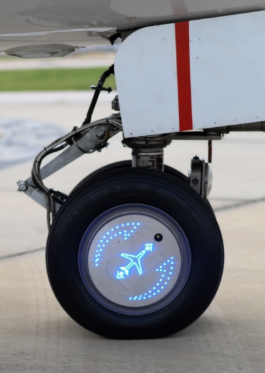
In commercial aviation, much of the focus on innovation has traditionally been centered on what occurs in the air: faster routes, newer aircraft designs, and improved fuel efficiency. Yet this often looks beyond the issues that exist lower on the ground, ones that both passengers and airlines alike experience. This persistent challenge of long waits for pushback clearance, waiting at the gate, and congested taxiways can continue to add time and cost to flight operations. One company, WheelTug, has been spearheading an innovation to change the trajectory of ground systems.
WheelTug is an in-wheel electric taxi system designed to help aircraft move independently on the ground without the use of external tugs or main engines. The system integrates a compact electric motor within the aircraft’s nose wheel, powered by the auxiliary power unit (APU). This allows pilots to maneuver forward and backward under their own control, potentially reducing waiting times and simplifying ground operations.
With aviation being a highly time-sensitive realm, such efficiencies could carry significant operational value. Airlines continually look for ways to improve aircraft utilization, and even modest reductions in ground time can support additional flights or improve schedule reliability. For low-cost carriers operating multiple short sectors per day, the time savings can add up meaningfully across the network.
“We’re addressing a problem that every traveler can relate to, ” WheelTug’s CEO, Isaiah Cox, states. “We’ve all sat in an aircraft that’s ready to go, only to be told there’s another plane in the way or that we’re waiting for a tug. What we’re doing is making it possible to go from doors closed to taxiing forward in under a minute.”
And minutes, in aviation, can have a significant impact on an airline’s profitability, increasing operations margins by 0.43% in Europe. WheelTug’s innovation aims to save 7 minutes for every airline by eliminating tugs, pre-taxi engine starts, engine start clearances, and wingmen.
Cox compares the experience to urban transport systems. “When someone boards a subway, they use two or three doors, and everyone’s on board in seconds,” he explains. “Airplanes, by contrast, typically use only one. With WheelTug, we’re attempting to make it feasible to use both the front and rear doors for boarding and deplaning, a change that could save a good portion of time per turnaround.”
WheelTug also addresses environmental and safety considerations. The system enables aircraft to taxi or to get to the runway before takeoff using electric power from the Auxiliary Power Unit (APU) rather than running jet engines. This is designed to help in reducing fuel use, emissions, and noise levels during ground operations, all growing priorities for airports and local communities. Cox points out that eliminating the need for tugs could also decrease minor ground incidents, further reducing delays.
Jan Vána, WheelTug’s Director of Business Development, notes that the system can also improve maneuverability in tight tarmac areas, allowing sharper turns and reducing the need for external equipment. “Our goal is to make ground movement more predictable and flexible,” he says.
While electric taxi technology is not entirely new, WheelTug’s approach, integrating the system directly into the aircraft rather than relying on external vehicles, makes it one of the distinctive contenders in this emerging space.
Cox acknowledges that the journey has been long. The first public demonstration took place in 2005, and the technology has evolved dramatically since then. “The early prototypes were rough, but they worked,” he recalls. “Today, the system is almost invisible, built seamlessly into the wheel assembly.”
As aviation continues to find solutions to become more sustainable and efficient, technologies that improve ground flow will increasingly be central to this vision.
WheelTug’s concept reflects a broader industry shift, where it’s looking beyond the skies to find areas where delays are most visible, at the gate and on the taxiway, and changing that trend effectively. “Flying has always been about speed. What we’re doing is giving a bit of that speed back to the ground,” Cox adds.